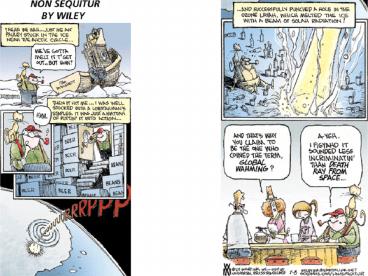Chemistry of the Stratosphere Stratospheric Ozone PowerPoint PPT Presentation
1 / 33
Title: Chemistry of the Stratosphere Stratospheric Ozone
1
(No Transcript)
2
Chemistry of the Stratosphere Stratospheric
Ozone
- Ozone plays a vital role in the atmosphere as the
principal absorber of 240 -320 nm radiation. It
acts as an important filter of highly energetic
radiation capable of causing severe damage to
living cells. - Ozone Layer implies localized region of the
atmosphere where ozone concentrations are high - Ozone concentrations are highest in the
stratosphere but also present in the troposphere - present as a trace component
- even at maximum concentrations of 10 ppmV
3
Stratospheric Ozone
- Total ozone concentration is small but of great
importance in the stratosphere - if compressed to 1 atm at 0 ºC, the ozone
thickness measures only 3 mm. - O3 thickness measured in Dobson Units
- G.M.B. Dobson 1920s-1930s
- 1 D.U. 0.01 mm thickness at S.T.P.
- Ozone columns usually have thicknesses of 300
D.U.
4
(No Transcript)
5
(No Transcript)
6
Formation and Destruction of Ozone
- Photochemical formation and destruction of ozone
- Each day, 350,000 tonnes (3.5 x 108 kg) of O3
are made and destroyed
7
Formation and Destruction of O3
8
(No Transcript)
9
Formation and Destruction of O3
- Note
- Energy difference accounted for by the excitation
energies of O2 ( 90 kJ/mol) and O (188 kJ/mol) - Reactions are energy releasing ( h? ? K.E. )
- Photochemical production O3 at night O3 at
end of day
10
Analysis of Ozone Concentrations
- Steady state concentrations of ozone
- (rate of production rate of destruction)
11
Analysis of Ozone Concentrations
12
Analysis of Ozone Concentrations
13
Analysis of Ozone Concentrations
Usually fair to assume that k1O2 ltlt k3O3
(especially in the lower stratosphere) Since the
solar flux in the far UV is much smaller than the
solar flux in the near UV
14
(No Transcript)
15
O3 subject to large variations since the solar
flux varies throughout the day and seasonally.
But take the time averaged flux and look at O3
versus altitude ... The measured ozone profile
has the same shape as the calculated profile but
the calculated values are about 2 x too high
!!! There must be other ozone destruction
mechanisms!
16
(No Transcript)
17
Catalytic Destruction of Ozone
- O3 is metastable and can be destroyed by
catalytic chain reactions. Ozone is converted to
O2 by a chain carrier X (free radical) which is
regenerated in the process
(reaction 4 of Chapman mechanism) important
additional sink of O3!
18
Catalytic Destruction of Ozone
- Since formation of O3 is unaltered (determined
only by solar flux) additional sink lowers the
steady state concentration of O3 - X is a catalyst - A single X is removed by some
side reaction (termination reaction) - Many possible candidates for X, but 4 5 major
ones
19
Chlorine and Bromine
- one possible termination reaction
- Cl HO2? HCl O2
- Major sources of Cl and Br are CFCs and Halons
(fire extinguishers)
20
Nitric Oxide
- NO produced abundantly in the troposphere but
undergoes oxidation to NO2 and HNO3 and is then
rained out - N2O much less reactive (can reach stratosphere)
21
Nitric Oxide
22
Nitric Oxide
- importance of NO/NO2 cycle depends on altitude
- above 25 km, net effect is O3 loss
- 50 of all O3 destroyed in upper atmosphere
- below 23 km, net effect is to protect O3 from
destruction by taking it out of circulation
23
(No Transcript)
24
(No Transcript)
25
Additional Reactions in Stratospheric Chemistry
- Reactions comprising the Chapman mechanism and
the catalytic cycles involving Cl/Br, NO, OH, and
H do not account for all of the chemistry of the
stratosphere
26
Temporary Reservoirs of Active Species
- Catalytically active species can be converted
into substances which reduce their concentrations
but from which they can be regenerated - estimated that at any given time, ½ of
atmospheric nitrogen is tied up as HNO3
27
Temporary Reservoirs of Active Species
- NO2 regenerated by photolysis
- HCl is a temporary reservoir for Cl which can be
regenerated via
28
Interaction Between Cycles
- The catalytic cycles involving Cl/Br, NO, OH, and
H do not occur independently of each other - X from one cycle can react with XO from another
- affects both NO/NO2 and OH/HO2 cycles
29
Null Cycles
- Null cycles result in no net chemical change but
usually involve the conversion of sunlight to
kinetic energy - also can be viewed as a pseudo-equilibrium
- affects both NO/NO2 and OH/HO2 cycles
30
Initiation and Termination Reactions
- Net rates of the catalytic cycles depend on the
rates of radical initiation and termination - Most initiation reactions are photochemical and
their rates depend upon the intensity of sunlight
(approach zero in darkness)
31
Initiation and Termination Reactions
- Termination reactions remove radical chain
carriers from the system
32
(No Transcript)
33
(No Transcript)

